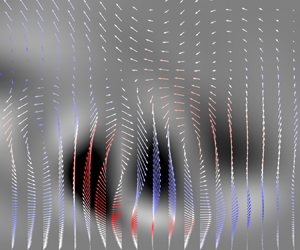No CrossRef data available.
Article contents
Sub-filter-scale shear stress analysis in hypersonic turbulent Couette flow
Published online by Cambridge University Press: 08 April 2024
Abstract

Direct numerical simulations of hypersonic turbulent Couette flows are performed for top-wall Mach numbers of 6, 7 and 8, inspired by non-reactive high-enthalpy wind tunnel free-stream conditions, with the goal of analysing the physical processes driving the sub-filter-scale (SFS) stresses to inform development of large-eddy simulation techniques for hypersonic wall-bounded flows. Semi-local scaling laws collapse mean profiles and second-order turbulent statistics well, in spite of the strong wall-normal gradients of temperature and density. On the other hand, the SFS shear stresses exhibit an unexpected profile characterized by a region of pronounced shear stress deficit, which becomes more pronounced for higher Mach numbers. Instantaneous visualizations suggest that the SFS shear stress deficit is induced by the counter-gradient resolved momentum transport driven by residual velocity motions at the interface between high-density low-speed streaks being ejected away from the wall, and low-density high-speed ones replacing the displaced fluid, qualifying this as a compressibility effect. It is shown that the SFS shear stresses are primarily driven by second-order interactions between residual velocities, in spite of their triply nonlinear nature. This, in turn, motivated a statistical quadrant analysis revealing the presence of a SFS shear stress deficit, that is, SFS processes driving momentum transport of the resolved field towards the top wall. Additionally, higher-Reynolds-number simulations reveal that there is an upper limit of spatial filter widths to resolve large-scale structures, and such deficit is observable at any Reynolds number when a reasonable spatial filter is applied.
- Type
- JFM Papers
- Information
- Copyright
- © The Author(s), 2024. Published by Cambridge University Press





